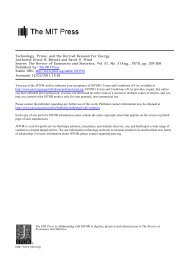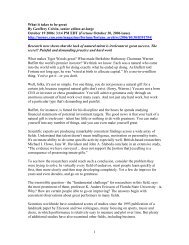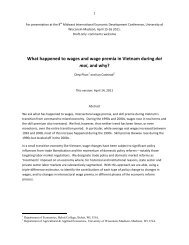Capital-Labor Substitution and Economic Efficiency Author(s): K. J. ...
Capital-Labor Substitution and Economic Efficiency Author(s): K. J. ...
Capital-Labor Substitution and Economic Efficiency Author(s): K. J. ...
You also want an ePaper? Increase the reach of your titles
YUMPU automatically turns print PDFs into web optimized ePapers that Google loves.
CAPITAL-LABOR SUBSTITUTION AND ECONOMIC EFFICIENCY 24I<br />
B. Factor Costs <strong>and</strong> Factor Proportions<br />
As shown in equation (2oa), the variation in<br />
factor proportions among countries, <strong>and</strong> among<br />
sectors in the same country, depends on o-, 8,<br />
<strong>and</strong> the relative factor costs. The U.S.-Japanese<br />
data are used in Chart 2 to provide a graphical<br />
CHART 2. - FACTOR COSTS AND OPTIMUM FAC TOR<br />
PROPORTIONS<br />
20 -CHEMICALS<br />
u10<br />
0ON<br />
(Logarithmic Scale)<br />
L<br />
TEXTILES<br />
APPAREL METAL FERR<br />
MININ METAL<br />
w 1 < C / gPOWER<br />
2 - X<br />
AGIULTURE<br />
/-U.S. FACTOR PROPORTIONS<br />
-JAPNESE FACTOR PROPORTIONS<br />
I .0 2 5 10 20 K<br />
CAPITAL-LABOR RATIO<br />
illustration of both types of variation. When<br />
both variables are expressed as logarithms, the<br />
capital-labor ratio is a linear function of the<br />
relative factor cost:<br />
log x = a log + log-. w<br />
In the United States, wages vary relatively<br />
little among sectors of the economy <strong>and</strong> the<br />
variation in capital intensity is due almost en-<br />
tirely to differences in 8 <strong>and</strong> o-. In Japan, how-<br />
ever, population pressure <strong>and</strong> underemploy-<br />
ment are reflected in large wage differentials<br />
among sectors. Chart 2 shows that low wages<br />
rather than the production function account for<br />
the low capital intensity in Japanese agricul-<br />
ture; if there were as small a wage differential<br />
as in the United States, agriculture would be-<br />
come a relatively capital-intensive sector in<br />
Japan on this analysis. Similarly, high wages<br />
contribute to the relatively high capital inten-<br />
sity observed in Japan in sectors like power <strong>and</strong><br />
non-ferrous metals.<br />
As between countries, changes in the relative<br />
capital intensity of sectors have great signifi-<br />
cance for international trade. Our results indi-<br />
cate that changes in the ordering of sectors by<br />
factor proportions are normal rather than ex-<br />
ceptional occurrences. The only sectors that<br />
are fairly immune to them are ones like power<br />
<strong>and</strong> apparel that have extremely high or low<br />
values of 8. A type that shifts its relative posi-<br />
tion a great deal is illustrated in Chart 2 by<br />
metal mining, which is quite capital intensive<br />
in the United States <strong>and</strong> quite labor intensive in<br />
Japan because of its high elasticity of substitu-<br />
tion. For the less extreme cases, wage differen-<br />
tials of the magnitude of that between Japan<br />
<strong>and</strong> the United States will cause factor reversals<br />
even with relatively small differences in elastic-<br />
ity, but for smaller wage differences the rank-<br />
ing would be more constant.<br />
Despite the approximate nature of our find-<br />
ings, the evidence of quantitatively significant<br />
reversals in capital intensity is too strong to be<br />
ignored.20 The assumption of invariance in the<br />
ranking of commodities by factor intensity that<br />
is used by Samuelson [ I 3 ] <strong>and</strong> other trade<br />
theorists appears to have very limited empiri-<br />
cal application.<br />
The varying possibilities for factor substitu-<br />
tion also have important consequences for the<br />
allocation of labor <strong>and</strong> capital at different in-<br />
come levels. If there were no such variation,<br />
the distribution of labor <strong>and</strong> capital by sector<br />
would correspond to the distribution of output<br />
except for differences in efficiency.2' In actu-<br />
ality, there are significant departures. Rising<br />
income leads to a declining share of primary<br />
production in total output <strong>and</strong> to an even more<br />
rapid decline in primary employment because<br />
of the high elasticity of substitution.22 On the<br />
other h<strong>and</strong>, the observed rise in the share of<br />
labor in the service sectors as income rises is<br />
probably due primarily to a low elasticity of<br />
substitution, since the share of service output<br />
does not appear to rise significantly [ 5]<br />
C. Variations in <strong>Efficiency</strong> <strong>and</strong> Prices<br />
Although they have received most attention<br />
in trade theory, factor proportions are not the<br />
only determinants of relative prices. A com-<br />
plete explanation must also take account of dif-<br />
'This aspect of our results <strong>and</strong> its implication for the<br />
problem of factor price equalization will be discussed by<br />
Minhas in a separate paper.<br />
21 Sector growth models using the Cobb-Douglas function<br />
are discussed by Johansen [8].<br />
22 In the case of underemployment, this tendency may be<br />
offset by low wages <strong>and</strong> low efficiency in agriculture, as in<br />
Japan.







